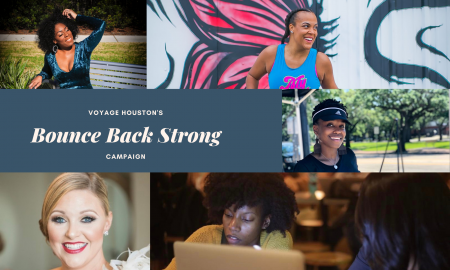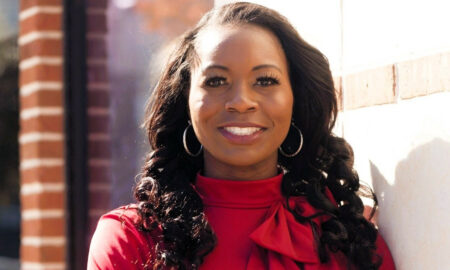

Today we’d like to introduce you to Holly Dool.
Holly, can you briefly walk us through your story – how you started and how you got to where you are today.
Here is how I got my start in dog rescue. We moved to Odessa in 2013 and were there for 2 years before moving back to the Houston area for my husband’s job. This was my story I wrote while living there. I wrote this over the year that I was fighting the City of Odessa for shelter reform.
When we moved to Odessa in June 2013 I had a very different idea of what my life would be like than the actual path my life took after moving there. I have been doing some form of animal rescue since 1999 but never to the extent that I feel ‘compelled’ to do in Odessa out of sheer necessity to save some of these dogs. I am now a 501C3. My rescue and the current Facebook page is called CAMO, Caring for the Animals of Midland/Odessa. At any given time we have 20-30 adoptable dogs needing homes. I rescue them from the shelter, vet them, and re-home them.
I first visited the Odessa Animal Control or OAC my 2nd week of living here. I stopped by to introduce myself as a ‘rescue’ person and was met with indifference by the shelter director and staff. Many shelters actually welcome rescues as a way to help reduce the number of dogs they have to euthanize. I could tell this would not be the case at this shelter. I walked through the shelter and was dismayed to see as many as 4-5 dogs per kennel in what I consider to be a very small facility for the size of booming Odessa, TX. I spotted a terrified little terrier that was trying to hide under her food and water bowl amidst 4 other dogs. She was shaking and it broke my heart. I began filling out the paperwork to adopt her and was told I needed a driver’s license that matched a current utility bill. Well having just moved the week before, I had not changed my driver’s license yet. I went to the DMV and waited in line for an hour to get a new license and went home to get a bill with our new address on it and then went back to the shelter to adopt the dog for a fee of $51. For the $51 fee, I received nothing but the dog. Most shelters adopt out dogs that are fully vetted, spayed or neutered with rabies shots for $60-$100 average. I felt it very strange to pay $51 for an animal without even the basic vaccinations. When you realize just how many new people are moving to Odessa that faces this same challenge it’s a wonder any animals are adopted at all! I was appalled at the lack of customer service from the staff and their indifference to my offer of help as a ‘rescue’ person. Thus began my journey with the City of Odessa’s Animal Shelter. In 5 months of living here, I have discovered that Odessa is in DIRE need of shelter reform. What plagues OAC can be summarized in two words: poor management.
The euthanasia rate at OAC speaks volumes. From Jan. 1, 2013 to Oct. 31, 2013, OAC took in 6520 dogs and cats and euthanized 5442. That is a euthanasia rate of 83.4 % (See Exhibit A). Only about 1.5 out of every 10 animals going into the shelter makes it out alive. The rest are in our city landfill! Of the 1512 dogs that were saved in those 10 months, 705 were adopted by the public, 314 were taken by rescue groups (over 200 of these 314 were dogs I pulled out of OAC), and 493 dogs and cats were reclaimed by their owners. As a comparison, last fiscal year Midland has taken in 6823 animals and only euthanized 2948, which is a euthanasia rate of only 43.2% or almost half of the number of dogs and cats killed compared to Odessa! Many cities such as Austin and San Francisco are turning toward no-kill and are achieving outstanding results. If a community is killing the majority of its shelter animals, it is because the local shelter has failed in its mission and this failure is nothing more than a failure of leadership. The bottom line is that OAC needs new leadership.
The shelter staff gives us a list of dogs and cats to be euthanized 2-3 times per week and we work off of the list to try to get as many adopted or into rescues as possible. The ‘list’ comes out anywhere from 10:00 am to 2:00 or 3:00 PM, with the norm being the latter part of the day and they give us until an hour before they close to ‘network’ the list unless they are feeling particularly retaliatory as they were this week and gave us a list at 8:37 a.m. and told us we had until 11:00 that morning to get any of the dogs off the list that we wanted to save (See exhibit B). That morning a citizen walked into the shelter at 11:12 to get a puppy that was on the euthanasia list, she was holding it when the kennel tech ripped it out of her arms to take it to be euthanized with its littermates and told her point blank that we were only given until 11:00 am to save them. (See Exhibit C). We’ve asked the staff for the list in advance so that we could have more time to network the animals. That has not happened to date and we are then forced to scramble to save some of these animals at the last minute. Granted, the volunteers are networking these dogs all day, every day on their Facebook site, Speaking Up For Those Who Can’t. The volunteers go into the shelter daily to update the photos of adoptable dogs to try to draw people into the shelter to either adopt a dog or cat or to try to get people to reclaim a missing dog or cat. They also work tirelessly nights and weekends networking these dogs into rescues. Most rescues are full, so to find a rescue to actually take a dog or cat is a small feat in itself. Then what often happens is that after spending hours trying to find a rescue that will work with us, we send them the animal they offered to take and it has either Parvo, Distemper or Kennel Cough and they tell us they can’t take dogs from us again. This happens over and over and the volunteers are constantly looking for rescues while we battle the internal issues at OAC. I’ve enclosed 2 local veterinarian’s letters mentioning the illness and disease that they see in their practices coming out of OAC regularly. (see exhibit D and E).
OAC also has an ‘isolation’ building (ISO) in which no one is currently allowed. The building is roughly the same size as the ‘Adoptables’ building and holds about the same number of dogs. However, we are not allowed to go back there. ISO is shrouded in mystery and the staff just say the dogs there are ‘unadoptable’. When I first moved here if you were missing a dog and ONLY if you were missing a dog were you allowed in the ISO building to look for your lost dog. One day I was asked to look for someone’s dog that was missing and went back there not knowing I wasn’t ‘allowed’ in there. My experience in ISO was appalling and I have included the story (see Exhibit G). Currently, the building is closed off to everyone, even those missing a dog and you are required to describe your dog to the staff and they will ‘look’ to see if it’s there. Personally, since OAC staff members do not have training and are hired off the streets, they label most dogs as Shepherds, Chihuahuas, Pit Bulls or Labs. I certainly wouldn’t trust them to look for my lost dog!! (See Exhibit H). As if this exclusion from ISO isn’t bad enough, the shelter director asked the volunteer group to purchase a flat screen TV so that the images of the dogs in ISO could be seen at the front desk for people who are looking for their lost pets since no one is permitted to go into the back. Not only was this expense incurred by the group, but now they must get updated pictures daily or risk a dog slipping through the cracks as many dogs are only given 3 days in the shelter. This is also not the first expense the group has incurred for the shelter. This summer the Speaking Up For Those Who Can’t volunteer Facebook group bought a 3-in-1 copier for the office manager to try to expedite the efficiency of getting new rescue groups approved. The group has also bought beds for all of the kennels, which currently need to be replaced. They also bought hand-sanitizing stations to try to stop the spread of disease and just this week the shelter ‘asked’ the volunteer group for refills for the stations (see exhibit I). The volunteer group also bought a scanner for the shelter to use to ‘scan’ dogs for microchips in case a dog’s owner had it microchipped. The shelter does NOT scan dogs for microchips upon arrival to the shelter or before euthanizing them. OAC desperately needs shelter reform a way to rally the public to be responsible for its overpopulation problem. Someone needs to lead this message to make a positive change for the animals! We need to stop the killing and to sweep away the employees, policies, procedures, and defeatist attitude that is currently at OAC.
The following is our ‘Wish List’ that would help us save more animals at Odessa Animal Control.
Our biggest ‘wish’ is a privately run shelter for the animals that are dying daily-through no fault of their own but simply for “being born”. We estimate this would cost $8-$10M, to expand the shelter to roughly 4 times it’s current size to allow for growth in the community.
In addition to a building that would house animals; both canine and feline; we would need a building where the following could be done:
• Veterinarian on staff-even if hired part time. We need trained and licensed personnel who have experience to work with the animals. A 12 hour class doesn’t cut it.
• Spay and neuters done before adopting out. This would help cut the population explosion we have here.
• Vaccinations given upon intake- to reduce the spread of disease in and out of the shelter.
• Separate facilities for pregnant dogs-cats. Currently at Odessa Animal Control, pregnant dogs-cats are put in kennels that are in the same area as other animals. This causes a great deal of stress on already traumatized animals. A facility with separate, clean and quiet areas for these animals is a must.
• Hire a behaviorist/trainer to work with each animal when brought in. In doing this, many animals can be evaluated and matched to the type of family situation that would be satisfactory for both the adopting family and the animal.
• Installation of a Microban floor to be able to disinfect for disease control.
We need change badly to bring this ‘shelter’ into the 21st century and in alignment with many other cities that are adopting a no kill stance. The numbers above reflect poorly on the City of Odessa and the community. We desperately need a partner to join us in our efforts to make OAC a better place for the animals. We are reaching out to the community and leaders of the community who may be able to help us in our fight to make OAC better for the animals. Please help us make a difference. ‘
The City actually took note and eventually hired a new shelter manager and the shelter has become much more rescue friendly. We moved back to Houston in 2015 and I promised my husband I would slow down with rescue. Well, fast forward to today and I have adopted out over 450 dogs already this year and we have 130+ dogs in foster homes from Houston to Dallas. We rescue mostly euthanasia listed, small dogs. We also take in the sick and injured dogs that other rescues can’t or won’t take. We also take in lots of seniors.
Great, so let’s dig a little deeper into the story – has it been an easy path overall and if not, what were the challenges you’ve had to overcome?
Animal rescue is never smooth! It is always chaos, with many ups and downs. We lost a dog yesterday, a senior we had rescued just a month before. She started declining rapidly and our vet said humane euthanasia was the only thing we could do. Today we have a dog that may or may not make it. She had been abandoned at NRG Stadium after Hurricane Harvey. The holding facility was only supposed to take in stray dogs from the storm, but Paris’s owners tried to surrender her to them and they said, ‘no, were only taking in strays’ They told them that if they didn’t take her they would just turn her loose in the parking lot. So, they took her in. Paris had a HUGE mammory tumor hanging from her stomach. No one adopted her or rescued her and she sat there for weeks. So we rescued her and she had surgery this week, but she ran into complications after surgery and her blood wasn’t clotting. She had to have transfusions and oxygen. One of our vets took her home for the weekend so he could keep an eye on her. When he called me this afternoon, he didn’t think she was going to make it. Paris is only a 2-3 year old Maltese, she shouldn’t have been put in this situation. Her owners let her down twice. Once by not spaying her (unaltered animals have a higher rise of getting cancer), but they let her down the 2nd time by dumping her when she needed them the most. Their problem became mine. In animal rescue, you begin to not like humans so much and gravitate to animals even more. They appreciate what we do for them!
Several months ago we rescued a tiny female Yorkie that was paralyzed and left in front of the Harris County Animal Shelter. She cost the rescue thousands of dollars, but her recovery was a huge success and it just makes you really think that they are all worth it, matter the time or cost. Luckily, the community and Yorkie lovers everywhere rallied for her and we were able to afford her medical bills and rehabilitation. She was our biggest success and had hundreds of followers.
Rescue is hard, very hard. It cuts into all aspects of your life, family and marriage. It costs money, it’s depressing, its worth it and its so frustrating all at the same time. This just went around Facebook, I don’t know who wrote it, but it is SPOT ON! This is rescue.
‘MAKE AN OFFER
We currently have for sale an animal rescue that has been around for 15 years, has an amazing reputation, and genuinely loves and cares about every animal that sets foot through our doors.
Let’s start with the major pros first:
We have no donations or extra money sitting around for pesky vet bills, so thank goodness you won’t have to be burdened by lots of money sitting in an account somewhere. Whew! You can start fresh! No worrying about how you’ll have to spend all the millions of dollars and never-ending funds everyone seems to think we, (and other rescues) have.
You won’t have the daunting task of finding animals to take into the rescue because we already have 31 in our care; 8 are HW+, two puppies have parvo, 2 puppies have pneumonia and an ongoing vet bill of $4,000+. We also have 3 bite cases, 2 unsocial and extremely skittish dogs, and the rest are all big dogs that everyone has looked over a million times. But hey, who doesn’t love special needs and high medical cost dogs, right? These ‘special’ dogs only make the rescue more valuable, don’t they?
We have a list of vets that like to slip in frivolous charges when fosters go in, which is just AWESOME, because who doesn’t enjoy being constantly kept on their toes? Then they are rude and shitty when they can’t get a hold of you every second of the day. And it’s always so fun to get a receipt for hundreds more than agreed on and discussed. When this happens, it will only strengthen you as a person, because then you get to go out and work even harder to cover the cost of those bills. You’ll sleep peacefully at night knowing your vet’s office is doing so well, they don’t need your business anymore and therefore can talk to you like you’re a piece of garbage. But hey, who doesn’t love a little controversy in life?
And let’s not forget about those adopters that come along every once in a while that really stir things up for you, because no one wants to be drama-free too long! They are the fun ones that will disregard your notices not to expose puppies to other dogs until fully vaccinated, and then they wonder why a month after adoption their pups are coughing, or come up with some other ailment. So to avoid being trashed all over social media, you pony up the cost of treating the dog you know didn’t get sick on your watch.
As an added bonus, we are throwing in a society that loves to criticize everything you do, albeit they never offer any help, have no idea what goes into rescue, and somehow seem to think rescue is a JOB and you get rich doing this. I mean, the last thing you want is people being keenly aware of how hard you work for no compensation. Who wants people empathizing with you anyways?
As if that weren’t enough, we will make sure to fast track you to becoming an ‘elite’ member of the rescue club, where people tear each other apart, instead of helping each other out. It’s so much better doing everything alone.
YOU WON’T GET PAID for any of it! That’s right, folks! No pay! Because who really wants to be burdened by having an income to pay their living expenses, etc? It’s so much more fun working two other ‘real’ jobs to pay for all of it.
Please tell us about CAMO Rescue.
We mostly rescue euthanasia listed animals from shelters across Texas and sometimes other states as well. We take the scared dogs usually mislabeled as ‘aggressive’ and many sick and injured dogs that other rescues can’t or won’t take.
Do you look back particularly fondly on any memories from childhood?
Visiting our friends farm near Fort Wayne, IN. We lived in the city and only had a dog. They lived on a farm and had horses, cows, cats and dogs. We had so much fun visiting there.
Contact Info:
- Address: CAMO Rescue
PO Box 15201 Mason Rd.
Sutie 1000-166 Cypress TX 77433 - Website: www.camorescue.com
- Phone: 832-520-1803
- Email: hollydool@hotmail.com
- Facebook: www.facebook.com/camorescue








Getting in touch: VoyageHouston is built on recommendations from the community; it’s how we uncover hidden gems, so if you know someone who deserves recognition please let us know here.


















Laura Wood
October 2, 2018 at 2:09 am
This was such a touching and inspiring story!! So true in the rescue and foster world!! I want to Thank this young Lady and her helpers for what she an they have done!!Not many have the courage or will take the time to do what she did!! I think that this article should be sent to every newspaper around, and plastered all over social media to open our public’s eyes on what is going on in some communities!! Thank you for this article!!!